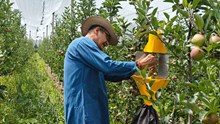
Your Land, Your Trees—But Still, Their Permission ?
Every time the government introduces a new regulation claiming to serve the “interests of farmers,” it’s as if an invisible emergency descends upon India's rural heartland. The phrase “for farmers’ benefit” has now become synonymous with a policy onslaught that’s likely to cost them more than it saves.
We've seen this play out with the Land Acquisition Bill that sought to hand over fertile farmland to corporate hands. We saw it again with the controversial farm laws-crafted without consulting farmers and forced upon the nation through parliamentary shortcuts. The outcome? A historic, sustained farmers' protest that made global headlines and eventually forced the government to retract.
Now, there's a new chapter in this saga: the Model Guidelines for Felling Trees on Agricultural Land. On the surface, it sounds green, forward-thinking, and environmentally responsible. But scratch the surface, and the harsh truth emerges: this is not about empowering farmers-this is about encircling them in yet another bureaucratic maze.
Chained to Their Own Roots: Farmers and the Politics of Trees :
Over the past two decades, millions of Indian farmers, lured by the promise of better returns and long-term sustainability, have planted timber-yielding trees like teak, shisham, gamhar, and arjun on their private agricultural lands. However, when the time comes to reap what they've sown, the system turns against them. Farmers find themselves grappling with a four-headed monster of bureaucracy:
1. The Forest Department, often synonymous with corruption and coercion;
2. The Revenue Department, more interested in measuring the farmer's social "worth" than his land;
3. The Panchayat, increasingly a hotbed of political manipulation and localized extortion;
4. The Agriculture Department, a digital fortress where ground realities are alien, and decisions are made in
spreadsheets, not soil.
To cut a tree on his own land, a farmer must now perform a ritual of permissions, paperwork, and portal entries. He must register on the National Timber Management System (NTMS), upload geotagged photographs of each tree, record its age, species, and height, and mark exact GPS coordinates in KML format. If he owns more than ten trees, a government verification agency will visit his land. Only after approval, uprooting, and submitting fresh stump photos can he consider selling the timber. What sounds like “digitization” is, in fact, a digital punishment for those whose hands still toil in the earth.
The Farmer Who Planted Trees Now Needs to Plead for an Axe
India imports over Rs 40,000 crore worth of timber and non-timber forest products every year. Shouldn’t this demand translate into opportunity for Indian farmers? Shouldn’t those who grow timber be allowed to profit from it—without being made to feel like criminals?
But instead, a farmer who nurtures a tree for 30 years must now beg for permission from a long list of officials—forest guards, panchayat secretaries, revenue clerks, agricultural officers, and digital gatekeepers.
In tribal belts like Bastar, Sarguja, and Amarkantak, where forest-based farming is ancestral tradition, even these guardians of the green must now navigate internet cafés and government websites to do what their forefathers did with dignity and wisdom.
The question is not why such regulations didn’t exist earlier—but why, now that they exist, were they made without consulting the farmers who will bear the brunt? Why were organisations like AIFA, CHAMF (www.chamf.org), ICFA, and other grassroots stakeholders completely excluded from the policy-making process?
Green Is the New Red Tape:
The government claims that this system is transparent and corruption-free. In reality, it’s a glorified portal piled on top of legacy corruption. The farmer must still grease palms, make multiple visits to offices, and chase approvals—only now, he must also understand KML files, upload tree videos, and navigate dropdown menus written in English.
How can we expect India’s 85% small and marginal farmers, most of whom own less than four acres and struggle to operate smartphones, to comply with such labyrinthine digital protocols? Is the goal to encourage agroforestry—or to punish those who believed in it?
If this regulation proceeds without major revisions, planting trees will no longer be an act of sustainability—it will become a legal liability.
From Plantation to Punishment: Time for Rethinking the Law
If the government genuinely wishes to combat climate change, expand green cover, and enhance rural incomes through agroforestry, it must act wisely:
1. Immediately suspend implementation of the current model rules.
2. Initiate dialogue with farmer organizations and stakeholders who've been planting, protecting, and
harvesting trees for years.
3. Design a simple, single-window, corruption-free process that prioritizes access for small farmers, is locally grounded, and does not demand internet literacy or technical acrobatics.
This law, in its present form, will not bring farmers closer to the forests—it will drive them away. It will make the act of planting trees feel like sowing the seeds of future punishment.
The farmer is not a criminal. And yet, this policy assumes that if he wishes to cut a tree, he must first prove his innocence, seek approvals for his intentions, and then seek permission to touch what he grew.
This is not ecological governance. This is bureaucratic colonization of the green economy.
Let Us Not Cut the Farmer Before the Tree
When a tree is cut, there is loss. But when a farmer’s autonomy, dignity, and trust are cut by the very system meant to protect him, the damage is far deeper.
Let’s not build green policies on red tape.
Let’s not measure climate commitment by how many permissions a farmer files.
Let’s start by treating the farmer not as a suspect, but as a solution.
Let planting remain a pride.
Let harvesting not become humiliation.
Only then can India truly grow green.
















